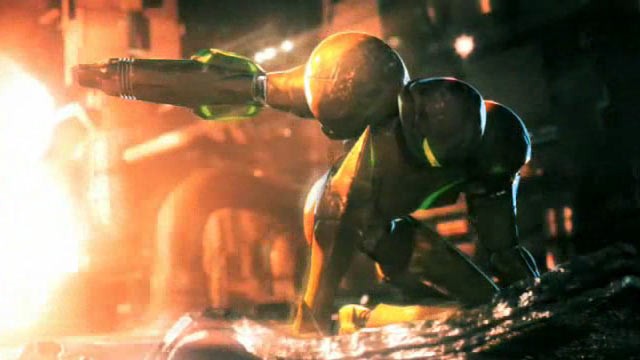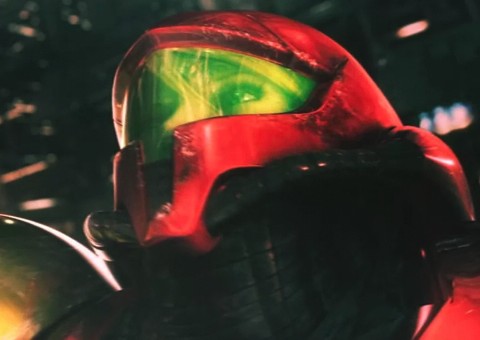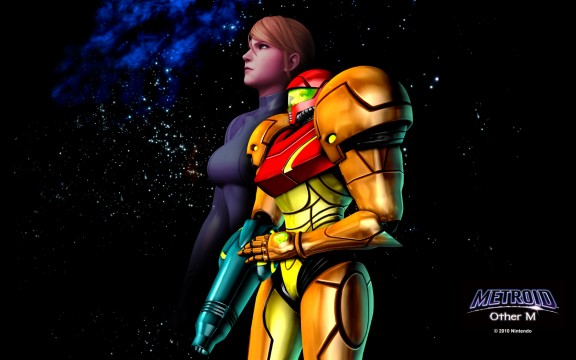
“The baby.”
It wasn’t that I objected to hearing Samus Aran speak for the first time in that opening cinematic for Metroid: Other M. Though the voice could perhaps have been a little throatier and intimidating, it got the job done. The objection for me, and many other fans, instead was to the words themselves, their tone, and the attitude of the person speaking them. Samus was the epitome of tough. This was a character who singlehandedly took on legions of foes in her games, laying waste to some of the most vile and frightening enemies imaginable. Samus made the Master Chief look like a boy scout. Yet there she was, speaking in an odd monotone and endlessly braying about the death of the hatchling Metroid that saved her life in Super Metroid.
The problem was that suddenly and inexplicably, Nintendo decided it was time to flip the script and focus on Samus’s femininity. When players reached the end of Metroid in 1987, they were surprised by the revelation that the little dude in armor they’d been guiding through the whole adventure was not a dude at all, but rather a woman. Considering that in 2014 the video game industry is still dominated by male protagonists, Samus’s reveal as a woman twenty-seven years ago was very daring. Nintendo was riding high with NES and could easily have chosen to play it safe with Sam Aran, but ever the trailblazers, decided to make this new hero female instead. What was more, she was strong, stoic, and brave, never pandering to the stereotypes of women characters in numerous other forms of media. Samus was a woman who was every bit the equal of any man. At the same time, what made her even more special was that Nintendo was never heavy-handed or preachy about Samus being a woman; her gender was a matter of trivia, and the games always put gameplay and her bravery front and center.
Now, I’m not suggesting that Nintendo was doing anything wrong by choosing to explore Samus’s identity as a woman. That’s a topic rich with potential from a narrative standpoint, and certainly something that doesn’t get as much attention as it deserves in the mainstream gaming market. The reason it felt off to me was that Nintendo had seemingly intentionally made a point of never qualifying Samus’s heroics as those of a woman. She was always simply a hero. Like Mario and Link, whose gender never factored into any of their adventures, Samus was free to be a hero that both women and men could admire without reservations. I personally felt Nintendo’s refusal to treat her any differently than its male characters was a huge nod of respect to Samus and female protagonists in general. When Other M came along, I was apprehensive because part of what made Samus so unique was about to be turned on its head, and I didn’t know if it was going to work. Lo and behold, I was right to be apprehensive, as Other M dealt a killer blow to Samus as a character.

A lot of folks like to point their finger at Other M developer Team Ninja for the drastic shift in Samus’s personality, but the blame rests squarely on the shoulders of her creator Yoshio Sakamoto. Team Ninja might have developed the game, but it was written, directed, and produced by Sakamoto (who also insisted on the Wii Remote-only control scheme). Intended to be an approachable action game, Other M also served the dual purpose of fleshing out Samus as a person. Nintendo was no stranger to controversy, and it certainly had produced some polarizing sequels in the past, but Other M marked the first time the company ever misstepped with the characterization of one of its characters.
For the duration of Other M, Samus is portrayed as tentative and almost timid. One of the more confounding examples of this in the game was when Samus and Ridley finally clashed, and she was paralyzed with fear at the sight of him. For anyone who had been a fan of the series perviously, it was an utterly perplexing sight given the situation of Other M in the Metroid timeline. According to Nintendo, Other M is sandwiched between the events of Super Metroid and Metroid Fusion; that means not only had she already gone through the events of Metroid and Metroid II, but the entirety of the Metroid Prime trilogy, as well. By the time Samus arrived in front of Ridley in Other M, she’d already encountered the guy numerous times, yet became randomly, unexplainably fearful of him. Coupled with her dreary observations about “the baby,” and Samus had become a caricature of a women from old science fiction anime and manga.
It was just too hard to accept that version of Samus as being the same character fans had come to know over years of playing her games. How Nintendo could give Sakamoto such free rein over Samus’s portrayal is unclear; surely they had to have noticed how much different the character had become under Sakamoto’s direction. The other thing I find strange about the whole debacle is that Nintendo knew how strongly fans felt about the Metroid Prime trilogy, which stuck to Samus’s classic representation perfectly. Other M might have been an attempt to lure in new players, but what they possibly could have hoped to gain from contradicting Retro’s work so blatantly is even more unclear. Whatever intentions Nintendo had were rendered moot once the game launched, as fans everywhere were left scratching their heads and bemoaning the loss of a beloved character.
Samus Aran is dead. But does she have to stay that way?

At this point, Nintendo has made multiple allusions to the return of Metroid, and the very real possibility that Retro has a good shot at being behind the wheel again, when it does. The real question is, what will it take to mollify Samus’s jaded fans? It’s a different situation for Nintendo than it was when Other M released. Gone are the masses of casual players who the company was so desperate to placate; Nintendo of 2014 is back to just trying to make the best games it can. As such, Metroid stands the chance of coming back reinvigorated much like it was when Metroid Prime launched on GameCube. This time, though, whoever champions her comeback is going to have to repair Samus’s image.
Some had qualms with Other M‘s heavy narrative presence, but I rather enjoyed the beautiful cutscenes (save for Samus, of course). Still, it would perhaps be wise to scale back the story for the next Metroid. Forget getting into Samus’s past any further, too; it’s been done, for better or worse, and the next game should be a clean slate. Metroid Fusion was the last entry in the series’ canon, so I say continue from there. Samus ended that game re-powered, so let’s put her on a quest to rebuild her armor, maybe to face off against the reborn threat of the Space Pirates. Give Samus a threat that only she can deal with, hopping from planet to planet and surviving by virtue of her wits and skills alone. Isolation and exploration weren’t just great for gameplay, they also revealed Samus’s uncanny perseverance and indomitable spirit. Make her someone to be feared again. Make her the Hunter once more.
Whatever you do, Nintendo, don’t deliver to fans the watered down husk that masqueraded as Samus in Other M. If you want to explore Samus as a woman again, keep in mind she’s one of the strongest women in the history of video games, not a stereotype. Most important of all though, Nintendo, is make sure that Samus’s story isn’t done, that Other M wasn’t the end of the line for her. Metroid isn’t Kid Icarus, isn’t F-Zero, isn’t Elite Beat Agents; Metroid is your third pillar and shouldn’t be sitting on the sidelines like it is. There can’t be a decade long gap between installments. Samus deserves redemption, and her fans deserve to see it. Metroid and Samus need to come home.




 ShareThis
ShareThis







Nice write-up Robert.
Ya know it’s frustrating: I received an email from Nintendo’s marketing department the other day (as I’m sure many Nintendojo readers did as well) with the subject line: “Metroid fans: Check out these new retro-styled side scrollers.”
What gives Nintendo? They use Metroid’s popularity in their marketing, but sit back & allow the franchise to lay dormant. If they keep this up, Nintendo won’t have “Metroid Fans” to send emails to. Why sit back and promote Guacamelee and Shovel Knight as being “like Metroid” if you’re not going to do anything with the franchise?
Also, regarding the timeline. I lived in Japan when the Primes came out and I can tell you, they weren’t well received. I say this with no knowledge of sales-data. Just that my Japanese gaming friends looked down on these “Western developed” first person games that “made them dizzy” (Not trying to speak for an entire country… again, this was just my experience.) Anyway, I was back in Japan visiting when “Other M” released and I have some pretty cool full-color booklets/pamphlets that are typical in Japanese game shops. The one I have has a very in-depth review of the entire Metroid series in time-line fashion. Ya know what? They don’t even mention Metroid Prime. It’s like a piece of revisionist history.
It is so interesting you say that. I’ve long been of the opinion that the Prime games are treated like second-class citizen titles in Japan. One reason, which might sound dumb, but what the heck, is that in Smash, Samus was never in a version of her Prime armor, it was always Super Metroid. Then, with the new game, Nintendo has made a point of saying she’s in her Other M armor. Like you said, as though the Prime games never happened. I find it distressing, to say the least. I think your experience might be more representative than you think. There’s no doubt Nintendo values the sales of the Prime games, but I think until very recently Nintendo didn’t value their quality.
One more thing, I also have wondered if Other M was so forcefully different than the Prime games as a way of “taking back” the series from Retro. Like maybe Nintendo or Sakamoto didn’t like how synonymous the series had become with Retro. Mind you, this is all just based on my own random thoughts, nothing concrete.
I disagree somewhat with your assertion that Samus’ gender was just a small bit of trivia in the Metroid games. The tone of the Metroid games beautifully gelled with a female heroin in that they were action heavy but not loaded with boastful “look at me! I’m a badass!” sensibilities. We never saw Samus rushing into a room, effortlessly blasting a bunch of monsters, and then making some Duke Nukem-like wisecrack about how awesome she was. She was a very real and thoughtful character who was more interested in survival and rescue (as well as exploring and uncovering the secrets of her surroundings) than “kicking ass and chewing bubblegum!!!”
In many ways, Samus’ character in the Metroid Prime games was an antidote to what Lara Croft had become in her last few Tomb Raider games. Croft’s development, ironically, went to the opposite extreme of Samus’. Going from being a perfect representation of the modern female in the first game to “Arnold Schwarzenegger With Titties” in Tomb Raider Chronicles.
Samus, in the classic Metroid and Metroid Prime games, was a perfect example of a female heroin done right: brave and smart but also compassionate and self aware.